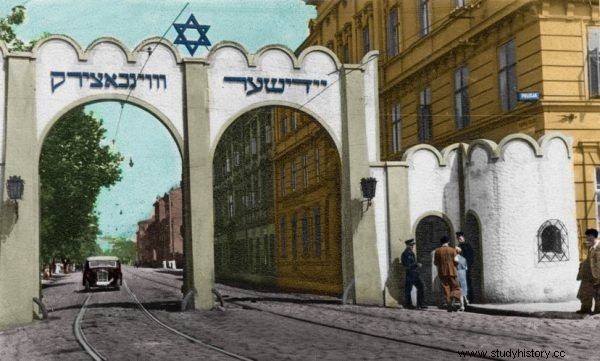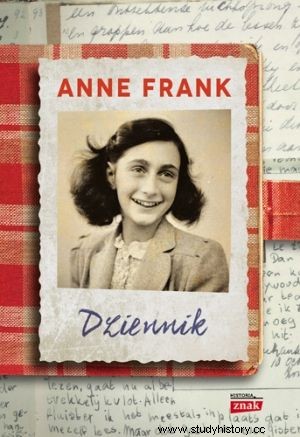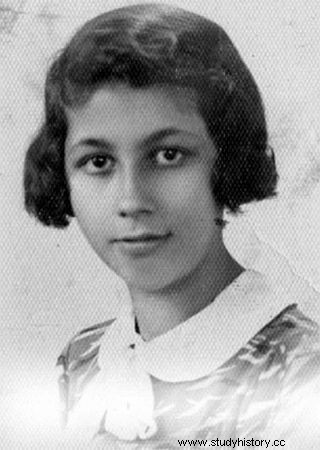A Jewish girl, hiding from the Nazis in Amsterdam for two years, became one of the most famous victims of the Holocaust. Thanks to the touching diary, everyone knows who Anne Frank was. It's time to remind you that it was not the only one. We present little diarists from Poland. Forgotten witnesses of the Holocaust.
I don't want to be a dog anymore. "The Diary" by Reni Knoll
One day in March 1943, Kazimierz Paciorek, an employee of the paper mill in Jeziorna near Warsaw, was looking through the piles of waste paper intended for grinding. Flipping yellowed sheets of paper, he came across an unusual find. At first glance, it was an ordinary school lined notebook. However, his attention was drawn to the inscription on the cover:"Diary - Renia Knollówna - Book I - 1941". He quickly realized it was a Jewish child's diary. He decided to hide it.
When World War II broke out, Renia was only 12 years old. She was the daughter of Ozjasz and Lea Knoll - Krakow Jews. She also had a younger sister, Sabina. The girl was very resolute, well-read, she liked to learn. Her family was strongly assimilated with Poles - her home was "traditionally Jewish, but not religious." However, it did not make any difference to the Germans who entered Krakow on September 6, 1939.

Gate I of the Krakow ghetto. It was there in the spring of 1941 that Renia Knoll went with her entire family.
The first note in Renia's diary appears on Thursday, May 16, 1940: "I am Renia Knollówna, I am 13. On May 6, there was a dance at my cousin Fredzia Spirówna". The next pages confirm that the diary is far from an occupation chronicle. Reni's notebook, like Anne Frank, is primarily a secretary and a collection of teenagers' everyday experiences.
There are descriptions of flirting, funny anecdotes, poems and drawings , all interspersed with brief information about life in the Krakow ghetto, where the Knolls found themselves in the spring of 1941.

One of the pages of Renia Knoll's journal with an entry from May 16, 1940. Photo originally published on the website of the Jewish Historical Institute.
The last entry is dated September 1, 1941 and is a farewell to the diary.
What a delight and satisfaction it will be to go out after the war without an armband, to feel like a human again, and not a homeless ragged dog. What a pleasure it will be not to feel hateful eyes on you! Go to school! Have boys! Skate and ski freely. .
Renia survived the war - we know her further fate thanks to the account she gave to Laura Eichhorn from the Jewish Historical Institute in December 1945. We know that she lost her family in the Płaszów camp; that she herself was saved by escaping from the ghetto.
Immediately after the war, she planned to go to Palestine, but it is difficult to establish whether she managed to do so. Ten years later, Kazimierz Paciorek learned about the anniversary of the Warsaw Ghetto Uprising and decided to return the notebook he found during the war. The "Diary" finally found its way to the JHI and was published in 2012

Tens of thousands of children found themselves in the Warsaw ghetto. Among them was also Mary Berg (source:Bundesarchiv; photo:Ludwig Knobloch; lic. CC BY-SA 3.0).
American outsider. "Diary from the Warsaw Ghetto" by Mary Berg
Mary Berg, or rather Mirriam Wattenberg, was born in 1924 and was the daughter of Stanisław, an antiquarian art dealer from Łódź, and a Jewish woman with American citizenship, Sylwia. When the war broke out, she spent holidays in Ciechocinek with her parents and sister. Sensing the conflict in the air, in August 1939, she began to keep her diary, in which she meticulously described the surrounding reality.
After her return to Łódź, her family was hit by the first persecution. For a moment it seemed that the Wattenbergs were in a privileged position after all. Sylwia was an American citizen, and so were her daughters. Counting on the protection of the American consulate, they moved to Warsaw, but there they were quickly confined to the ghetto, along with tens of thousands of the capital's Jews.
Mary continued to write. As a US citizen, she wore an American flag on her clothes, which allowed her to move freely in the ghetto and protect her from persecution.

The inspiration for this article was Anne Frank's Diary (Znak Horizon 2015).
She used her privileges - she was everywhere and described everything:café life, as well as conspiratorial activities or the backstage of shooting a propaganda film by the Germans. Although she never fully experienced hunger herself, she described the tragedy of people who were not so lucky:
I saw half-naked, dirty children lying listlessly on the floor. A lovely four or five-year-old girl was sitting in the corner, crying. I couldn't help but stroke her messy blond hair. The child looked at me with big blue eyes and said, "I'm hungry" (June 12, 1941) .
In June 1942, on the eve of the first deportations to Treblinka, she was transported with other citizens of the USA and Great Britain to Pawiak. She spent several months there - she used this time to write down the accounts of her fellow prisoners. She also observed the slow extermination of the ghetto from behind bars, incl. the liquidation of the Janusz Korczak Orphanage.

Rutka Laskier, author of "Diary" from the Będzin ghetto.
At the beginning of the following year, she was transferred to an internment camp in Vittel, France. Thanks to the exchange of German prisoners of war interned by the Allies, in 1944 she managed to leave Europe.
She went to New York. There she met the journalist Szmuel Lajb Shneiderman, to whom she showed her journals. They were soon issued as the first eyewitness testimony to the Holocaust. Mary lives in the US to this day, but distanced herself from the discussions that arose after the publication of her journal.
I wanted this to stay after me. "Diary" by Rutka Laskier
Rutka Laskier was the daughter of Jakub and Dwojra Laskra and one of nearly 30,000 Jews who lived in Będzin before the war. Her family was quite wealthy - they owned a mill. Rutka had a younger brother, Henius. She was a beautiful young girl, friends from high school called her a model. She loved to learn - wanted to drown her head in the books .

Before the war, over 20,000 people lived in Będzin. Jews who peacefully coexisted with Poles. After the occupation began, the Germans quickly restored their order in the city. Already on the night of September 8-9, 1939, they burned down the synagogue, and in 1942 created a ghetto. The photo shows the ruins of the synagogue.
In May 1942, a ghetto was established in Będzin, in which the Jewish inhabitants of the so-called Ostoberchlesien. Rutka soon began to keep a diary in an ordinary, green notebook. Already in the first sentences, she outlines the situation in which she found herself: I cannot realize that it is already 43 years, the fourth year of this hell .
The girl's diary is short, but on several dozen pages it contains a moving description of the two worlds in which she was located. The first was her own, full of problems that teenagers grapple with. Youthful love, growing up. Trivial matters in retrospect, but how important when you are thirteen. The second was the ghetto. Awareness of the impending death and the crisis of faith:
That little bit of faith that I once had has shattered completely. G If there was a God, he would not have allowed people to be thrown alive into the furnace and young children had their heads smashed with rifles, or bagged and gassed ... (5 Feb 1943).

A photo from 1942 showing one of the streets of the Będzin ghetto.
In the face of the impending deportation, Rutka asked her friend, a Polish woman, Stasia Sapińska, to keep her diary:"I would like it to stay after me." In August 1943, along with other Będzin Jews, she was sent to Auschwitz. She was only 14 years old. She probably died in the gas chamber, although the account of the camp prisoner, Zofia Minc, has also been preserved, who claimed that Rutka survived the selection and died only later - of cholera.
In 2006, the world heard the message "A diary of a Jewish girl from Będzin has been found!" Nobody could believe that Stanisława Sapińska had kept the testimony of the extermination of Będzin Jews for over 60 years. And yet - the diary was soon published in several languages, and Rutka was hailed as the "Polish Anne Frank".
Bibliography:
- Justyna Kowalska-Leder, The Holocaust Experience from the Child's Perspective in Polish Personal Document Literature , Wrocław 2009.
- Mary Berg, Diary from the Warsaw Ghetto , Warsaw 1983.
- Renia Knoll, Journal , Warsaw 2012.
- Rutka Laskier, Diary , Bedzin 2008.
